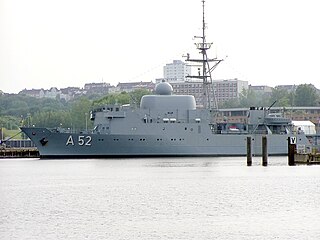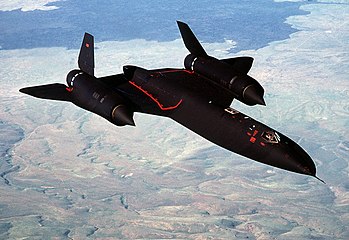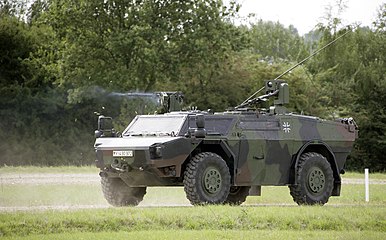Reconnaissance
This articleneeds additional citations forverification.(February 2012) |
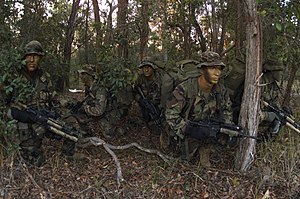
Inmilitaryoperations,military reconnaissanceorscoutingis theexplorationof an area bymilitaryforces to obtain information about enemy forces, theterrain,and civil activities in thearea of operations.In military jargon, reconnaissance is abbreviated torecce(British, Canadian, Australian English) and torecon(American English), both derived from the root wordreconnoitre.[1]
The types of reconnaissance includepatrollingthe local area of operations andlong-range reconnaissance patrols,which are tasks usually realized in the United States of America byU.S. Army Rangers,cavalry scouts,and military intelligence specialists, using navy ships andsubmarines,reconnaissance aircraft,satellitesto collect raw intelligence; and establishingobservation posts.Moreover,espionageis different from reconnaissance, because spies work as civilians in enemy territory.
Etymology[edit]
Reconnaissance is a mission to obtain information by visual observation or other detection methods, about the activities and resources of an enemy or potential enemy, or about the meteorologic, hydrographic, or geographic characteristics of a particular area.[2]
Reconnaissance (US Army FM 7-92; Chap. 4)
The word is derived from theMiddle Frenchwordreconoissance.[3]
Overview[edit]


Reconnaissance conducted byground forcesincludesspecial reconnaissance,armored reconnaissance,amphibious reconnaissanceand civil reconnaissance.
Aerial reconnaissanceis reconnaissance carried out by aircraft (of all types including balloons and uncrewed aircraft). The purpose is to survey weather conditions, map terrain, and may include military purposes such as observing tangible structures, particular areas, and movement of enemy forces.
Naval forces use aerial and satellite reconnaissance to observe enemy forces. Navies also undertakehydrographic surveysandintelligence gathering.
Reconnaissance satellitesprovide military commanders with photographs of enemy forces and other intelligence. Military forces also use geographical and meteorological information fromEarth observation satellites.
Discipline[edit]
Types of reconnaissance:
- Terrain-orientedreconnaissance is a survey of the terrain (its features, weather, and other natural observations).
- Force-orientedreconnaissance focuses on the enemy forces (number, equipment, activities, disposition etc.) and may includetarget acquisition.
- Civil-orientedreconnaissance focuses on the civil dimension of thebattlespace(areas, structures, capabilities, organizations, people and events abbreviated ASCOPE).
The techniques and objectives are not mutually exclusive; it is up to the commander whether they are carried out separately or by the same unit.
Reconnaissance-in-force[edit]

Reconnaissance-in-force (RIF) is a type ofmilitary operationormilitary tacticused specifically to probe an enemy's combat ability.
While typical reconnaissance forces are small and armed only for self-defense, RIF use considerable (but not decisive) force in order to elicit a strong reaction by the enemy that more accurately reveals its own strength, deployment, preparedness, determination, and other tactical data. The RIF units can then fall back and report this data, or expand the conflict into a full engagement if enemy weaknesses are revealed.
Other methods consist ofhit-and-run tacticsusing rapid mobility, and in some cases light-armored vehicles for added fire superiority, as the need arises.
Maintaining active RIF can be used to limit, or even deny, enemy reconnaissance.
Nazi Germany's reconnaissance during World War II is described in the following way:
The purpose of reconnaissance and the types of units employed to obtain information are similar in the U.S. and the German Armies. German tactical principles of reconnaissance, however, diverge somewhat from those of the U.S. The Germans stress aggressiveness, attempt to obtain superiority in the area to be reconnoitered, and strive for continuous observation of the enemy. They believe in employing reconnaissance units in force as a rule. They expect and are prepared to fight to obtain the desired information. Often they assign supplementary tasks to their reconnaissance units, such as sabotage behind enemy lines, harassment, or counter-reconnaissance.
Only enough reconnaissance troops are sent on a mission to assure superiority in the area to be reconnoitred. Reserves are kept on hand to be committed when the reconnaissance must be intensified, when the original force meets strong enemy opposition, or when the direction and area to be reconnoitred are changed. The Germans encourage aggressive action against enemy security forces. When their reconnaissance units meet superior enemy forces, they fight a delaying action while other units attempt to flank the enemy.[4]
Reconnaissance-by-fire[edit]
Reconnaissance by fire(orspeculative fire) is the act of firing at likely enemy positions to cause the enemy force to reveal their location by moving or by returning fire.[5]
Reconnaissance-pull[edit]
Reconnaissance-pull is a tactic that is applied at the regiment to division level and defined as locating and rapidly exploiting enemy weaknesses. It is the ability to determine enemy positions and create exploitable gaps through which friendly forces can pass while avoiding obstacles and strong points.[6]
A textbook example of reconnaissance-pull was documented during theTinian landingsofWorld War II,utilized by theUnited States Marine Corps'sAmphibious Reconnaissance Battalion,fromV Amphibious Corps.Aerial photography and the confirmation by theamphibious reconnaissanceplatoonsdetermined that the Japanese defenders had largely ignored the northern beaches of the island, focusing most of their defensive effort on beaches in the south-west which were more favorable for an amphibious landing. American forces quickly changed their landing location to the northern beaches and planned a small and hasty "deception"operation off the southern beach, which resulted in a complete surprise for the Japanese forces. As a result, American forces were able to fight the Japanese force on land, where they had the advantage, leading to light losses and arelatively short battlethat lasted only 9 days.[7]
Types[edit]
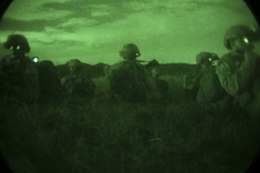
When referring to reconnaissance, a commander's full intention is to have a vivid picture of hisbattlespace.The commander organizes the reconnaissance platoon based on:
- mission,
- enemy,
- terrain,
- troops and support available,
- time available, and
- civil considerations.
This analysis determines whether the platoon uses single or multiple elements to conduct the reconnaissance, whether it pertains toarea,zone,orroute reconnaissance,the following techniques may be used as long as the fundamentals of reconnaissance are applied.
Scouts may also have different tasks to perform for their commanders of higher echelons, for example: theengineer reconnaissancedetachments will try to identify difficult terrain in the path of their formation, and attempt to reduce the time it takes to transit the terrain using specialist engineering equipment such as apontoon bridgefor crossing water obstacles.Sanitary epidemiological reconnaissanceimplies collection and transfer of all data available onsanitaryandepidemiologicalsituation of the area of possible deployment and action ofarmed forces,the same data for the neighboring and enemy armed forces. The aim for the reconnaissance is to clear up the reasons of the specific disease origin- sources of theinfectionin various extreme situations, including localwarsandarmed conflicts,the ways of the infection transfer and all factors promoting to theinfestation.
After the armed forces have become stationary during wartime and emergency of peacetime the sanitary epidemiological reconnaissance turns into sanitary and epidemiologicalsurveillanceand medical control of vital and communal activity of the armed forces.[8][9]
Area[edit]

Area reconnaissance refers to the observation, and information obtained, about a specified location and the area around it; it may be terrain-oriented and/or force-oriented. Ideally, a reconnaissance platoon, or team, would use surveillance or vantage (static) points around the objective to observe, and the surrounding area. This methodology focuses mainly prior to moving forces into or near a specified area; the military commander may utilize his reconnaissance assets to conduct an area reconnaissance to avoid being surprised by unsuitable terrain conditions, or most importantly, unexpected enemy forces. The area could be a town, ridge-line, woods, or another feature that friendly forces intend to occupy, pass through, or avoid.[2]
Within anarea of operation(AO), area reconnaissance can focus the reconnaissance on the specific area that is critical to the commander. This technique of focusing the reconnaissance also permits the mission to be accomplished more quickly. Area reconnaissance can thus be a stand-alone mission or a task to a section or the platoon. The commander analyzes the mission to determine whether the platoon will conduct these types of reconnaissance separately or in conjunction with each other.[2]
Civil[edit]
Civil reconnaissance is the process of gathering a broad spectrum of civil information about a specific population in support of military operations. It is related to and often performed in conjunction with infrastructure reconnaissance (assessment and survey). Normally the focus of collection in the operational area for civil reconnaissance is collecting civil information relating to the daily interaction between civilians and military forces. Civil information encompasses relational, temporal, geospatial and behavioral information captured in a socio-cultural backdrop. It is information developed from data related to civil areas, structures, capabilities, organizations, people, and events, within the civil component of the commander's operational environment that can be processed to increase situational awareness and understanding. The type of civil information that is needed in order to support military operations varies based on the environment and situation.[10][11]
Route[edit]

Route reconnaissanceis oriented on a given route (e.g., a road, a railway, a waterway; i.e., a narrow axis or a general direction of attack) to provide information on route conditions or activities along the route. A military commander relies on information about locations along his determined route: which of those that would provide best cover and concealment; bridge by construction type, dimensions, and classification; or forlanding zonesor pickup zones, if the need arises.[2]
In many cases, the commander may act upon aforce-orientedroute reconnaissance by which the enemy could influence movement along that route. For the reconnaissance platoons, or squads, stealth and speed—in conjunction with detailed intelligence-reporting—are most important and crucial. The reconnaissance platoon must remain far enough ahead of the maneuver force to assist in early warning and to prevent the force from becoming surprised.[citation needed]
It is paramount to obtain information about the available space in which a force can maneuver without being forced to bunch up due to obstacles.Terrain-orientedroute reconnaissance allows the commander to obtain information and capabilities about the adjacent terrain for maneuvering his forces, to include, any obstacles (minefields, barriers, steep ravines, marshy areas, orchemical, biological, radiological, and nuclearcontamination) that may obstruct vehicle movement—on routes to, and in, his assigned area of operations. This requirement includes the size of trees and the density of forests due to their effects on vehicle movement. Route reconnaissance also allows the observation for fields of fire along the route and adjacent terrain. This information assists planners as a supplement to map information.[citation needed]
Zone[edit]
Zone reconnaissance focuses on obtaining detailed information before maneuvering their forces through particular, designated locations. It can be terrain-oriented, force-oriented, or both, as it acquire this information by reconnoitering within—and by maintaining surveillance over—routes, obstacles (to include nuclear-radiological, biological, and chemical contamination), and resources within an assigned location.[7]
Also,force-orientedzone reconnaissance is assigned to gain detailed information about enemy forces within the zone, or when the enemy situation is vague by which the information concerning cross-country traffic-ability is desired.[2]The reconnaissance provides the commander with a detailed picture of how the enemy has occupied the zone, enabling him to choose the appropriate course-of-action.
As the platoon conducts this type of zone reconnaissance, its emphasis is on determining the enemy's locations, strengths, and weaknesses. This is the most thorough and complete reconnaissance mission and therefore is very time-intensive.
Psychology[edit]
A tracker needs to pay close attention to both the environment and the psychology of their enemy. Knowledge of human psychology, sociology, and cultural backgrounds is necessary to know the actions of the enemy and what they will do or where they will go next. Chief of ScoutsFrederick Russell Burnhamcommented on reconnaissance and scouts, saying:[12]
It is imperative that a scout should know the history, tradition, religion, social customs, and superstitions of whatever country or people he is called on to work in or among. This is almost as necessary as to know the physical character of the country, its climate and products. Certain people will do certain things almost without fail. Certain other things, perfectly feasible, they will not do. There is no danger of knowing too much of the mental habits of an enemy. One should neither underestimate the enemy nor credit him with superhuman powers. Fear and courage are latent in every human being, though roused into activity by very diverse means.
Gallery[edit]
-
A Soviet convoydeployingintermediate-range ballistic missilesin Cuba, 1962, as first revealed by aLockheed U-2.
-
German ArmyFennekreconnaissance vehicle
See also[edit]
- Exploration
- Espionage
- Intelligence, surveillance, target acquisition, and reconnaissance
- List of reconnaissance units
- Pathfinder (military)– airborne pathfinders
- Spatial reconnaissance
- Special reconnaissance(recon team)
- Surveillance aircraft
- U.S. military doctrine for reconnaissance
References[edit]
- ^Wragg, David W. (1974).A Dictionary of Aviation(1st American ed.). New York: Frederick Fell, Inc. p. 222.ISBN0-85045-163-9.
- ^abcdeField Manual (FM) 7–92: The Infantry Reconnaissance Platoon and Squad (Airborne, Air Assault, Light Infantry).United States Army.2001. p. 4.0.
- ^Dictionary.com
- ^WAR DEPARTMENT TECHNICAL MANUAL TM-E 30-451HANDBOOK ON GERMAN MILITARY FORCES, WAR DEPARTMENT • 15 MARCH 1945 (chapter IV, section II, "Reconnaissance"
- ^"Reconnaissance by fire".[dead link]
- ^"Reconnaissance-pull" —seeking the path of least resistanceArchived2016-03-04 at theWayback Machine(monograph, US Command and General Staff College, 1991)
- ^ab"Chap. 11".Marine Corps Operations (MCDP 1-0).Marine Corps Doctrinal Publication. 2007. pp. 11–10.
- ^Beliakov VD Military Epidemiology. Textbook in Russian. Leningrad, 1976 p153.
- ^Mel'nichenko P. I., Ogarkov O. I., Lizunov Yu. V.Military Hygiene and Military Epidemiology.400 pp., ill. 2005ISBN5-225-04849-8
- ^Burke, Kevin."Civil Reconnaissance; Separating the Insurgent from the Population"(PDF).NPS. Archived fromthe original(PDF)on 22 December 2016.Retrieved29 December2017.
- ^"Joint Publication 3-57"(PDF).US Government.Retrieved29 December2017.
- ^Burnham, Frederick Russell(1926).Scouting on Two Continents.Garden City, New York: Doubleday, Page & Company. p.19.ISBN978-0-86920-126-8.OCLC407686.
Further reading[edit]
- Halsall, Christine,Women of Intelligence: Winning the Second World War with Air Photos,The History Press, 2012.ISBN978-0-7524-6477-0.

